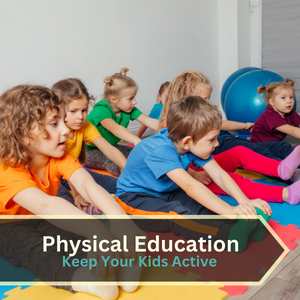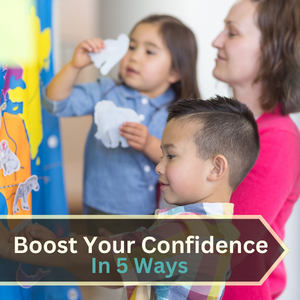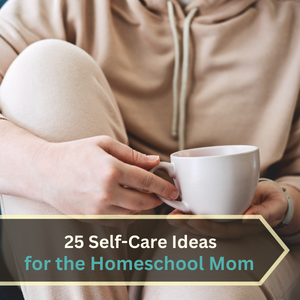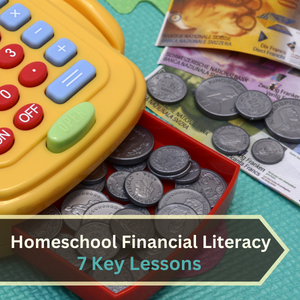Welcome to the energizing world of homeschool fitness! As a homeschool mom venturing into the homeschooling journey, you might wonder how to infuse your day with activity and fun. Today, let’s dive into creative homeschool physical education class ideas that will keep your kids moving and engaged.
Importance of Physical Education in Homeschooling
In the realm of homeschooling, homeschool fitness is more than just a subject; it’s a lifestyle choice. Physical education plays a pivotal role in developing a well-rounded homeschool curriculum. It’s not just about fitness; it’s about building confidence, enhancing learning capabilities, and establishing healthy habits that last a lifetime.
Challenges of Keeping Homeschoolers Active and Motivated
Are your homeschool students cooped up indoors, absorbed in books or screens? You’re not alone! One of the biggest hurdles in homeschool fitness is finding innovative ways to keep children motivated and moving. But fear not; as we embark on this journey, you’ll discover that the solution lies in creativity and a bit of planning.
This post will explore many homeschool fitness activities tailored for various age groups. From toddlers to teens, we’ve got you covered with ideas to make your homeschool PE sessions the highlight of your day!
Homeschool PE Activities for Early Childhood (Ages 3-5)
Fun Warm-Up Exercises for Little Ones
Start with something simple and playful. Animal walks, such as bear crawls or frog jumps, not only warm up those little muscles but also bring giggles and joy. These PE class activities are stellar for developing motor skills, a cornerstone of homeschool fitness in the physical education curriculum.
Simple Coordination and Balance Games
Balancing on one foot or walking along a line taped on the floor can be a fun p.e challenge for young kids. It’s about making homeschool fitness a game they love to play.
Interactive Storytelling with Physical Movements
Imagine a story where your child has to jump, duck, or twirl as part of the narrative. This method intertwines literacy with physical education, a unique approach to homeschool fitness.
Importance of Play and Movement at This Age
Play is the language of young children. Incorporating playful homeschool fitness activities not only keeps them active but also aids in their overall development. It’s about laying the foundation for a lifetime of health and fitness.
Activities for Elementary Age Children (Ages 6-10)
Introduction to Basic Sports Skills
Whether throwing a ball, skipping rope, or basic yoga poses, introducing structured homeschool fitness activities helps develop coordination and interest in various sports.
Creative Movement and Dance
Dance is a fantastic homeschool p.e lesson plan that keeps kids moving and allows them to express themselves while staying fit. Create a dance routine or have a spontaneous dance party. It’s about making homeschool fitness fun and expressive.
Obstacle Courses and Adventure Challenges
Set up simple obstacle courses in your backyard or living room. This promotes physical fitness and problem-solving skills, an essential aspect of homeschool education.
Integrating Educational Concepts into Physical Activities
Incorporate math or science into your homeschool fitness schedule. Counting steps, measuring jump lengths, or discussing the physics of ball movement can enrich their learning experience in homeschool p.e.
Engaging Pre-Teens (Ages 11-13)
Team Sports and Group Activities
At this age, homeschool fitness can include more structured team sports. Whether it’s soccer in the backyard or a friendly basketball game, it’s about learning teamwork and building sportsmanship.
Introduction to Fitness Challenges and Goal Setting
Introduce your pre-teens to fitness challenges. Set goals like a certain number of jumping jacks or running a specific distance. It teaches them about setting and achieving objectives, a valuable life skill.
Interactive Games that Encourage Strategy and Physical Activity
Games like Capture the Flag or Treasure Hunts get them moving and thinking. Homeschool fitness is not just about physical activity; it’s about engaging their minds.
The Role of Technology in Active Learning
In this digital age, leverage technology to enhance homeschool fitness. Apps and online videos can offer guided workouts or yoga sessions, providing diverse activities for your pre-teens.
High School PE Ideas (Ages 14-18)
Advanced Sports Techniques and Training
For your teens, homeschool fitness can take a more advanced turn. Introduce them to specific sports techniques, like basketball dribbling drills or soccer footwork. This enhances their skills and instills a sense of discipline and dedication.
Personal Fitness Programs and Tracking Progress
Encourage your high schoolers to create their own fitness programs. This could include a mix of cardio, strength training, and flexibility exercises. Tracking progress, perhaps through a journal or a fitness app, helps them see their growth over time, boosting motivation in their homeschool fitness journey.
Group Fitness Challenges and Competitive Sports
Introduce your teens to group fitness challenges. These could be family-oriented activities like hiking or biking, or they could join local sports teams. This involvement fosters community and competitive spirit, which are integral to homeschool fitness.
Preparing for Lifelong Fitness and Health Awareness
High school is the perfect time to instill lifelong fitness habits. In PE class, discuss topics like nutrition, mental health, and the importance of regular physical activity. Homeschool fitness is not just about the here and now; it’s about preparing them for a healthy future.
Adapting Activities for Different Skill Levels and Abilities
Inclusive PE Activities for Diverse Learners
Homeschool fitness should be inclusive, catering to various skill levels and abilities. Adapt games and activities so everyone can participate and feel successful. This approach fosters an environment of support and inclusivity.
Modifying Games and Exercises for Different Abilities
No two children are the same, and this is especially true in homeschool fitness. Modify exercises and games to suit individual needs. This could mean simplifying a game for younger kids or adding complexity for older ones.
Encouraging Peer Support and Teamwork
Part of your homeschool PE curriculum should foster an atmosphere where children encourage and support each other’s fitness activities. This builds a sense of community and teamwork, essential skills for life beyond homeschooling.
Motivation Strategies in Homeschool PE
Setting Achievable and Fun Fitness Goals
Goals are the backbone of motivation in homeschool fitness. Set achievable yet challenging goals for your kids. Celebrate their successes and encourage them through their struggles.
Reward Systems and Positive Reinforcement
Implement reward systems to keep motivation high. Once a fitness goal is met, this could be as simple as a sticker chart or a special outing. Positive reinforcement goes a long way in maintaining enthusiasm for homeschool fitness.
Involving Kids in Planning PE Activities
Give your kids a voice in their homeschool fitness journey. Let them help plan activities or choose sports they’re interested in. This ownership increases their engagement and enthusiasm.
Family Involvement and Group Challenges
Make homeschool fitness a family affair. Participate in activities with your kids or set up family fitness challenges. This not only keeps everyone active but also strengthens family bonds.
Utilizing Outdoor and Indoor Spaces Effectively
Outdoor Adventures and Nature Activities
Take advantage of the great outdoors for your homeschool fitness activities. Nature hikes, bike rides, or beach volleyball can be fun and physically rewarding.
Creative Indoor PE Ideas for Limited Spaces
Don’t let space constraints dampen your homeschool physical education class spirit. Indoor activities like yoga, dance routines, or simple stretching exercises can be effective and enjoyable.
Balancing Indoor and Outdoor Activities
Striking a balance between indoor and outdoor activities ensures a well-rounded homeschool fitness regimen. This balance keeps things fresh and exciting for your children.
Integrating PE with Other Homeschool Subjects
Cross-curricular activities that Include Physical Movement
Integrate physical education with other homeschool subjects. For instance, a history lesson could involve a reenactment of a historical event, combining learning with physical activity.
Learning Through Movement: Combining Educational Goals with Physical Activity
Combine educational goals with physical movement as part of your homeschool pe curriculum. For example, a science experiment could involve physical activity, like testing how exercise changes heart rate.
The Role of PE in Overall Homeschool Curriculum
Physical education is an integral part of the overall homeschool curriculum. It complements academic learning and contributes to the development of a well-rounded individual.
Reflections
We’ve explored many homeschool fitness ideas tailored for every age group. These activities keep your kids physically active and contribute significantly to their overall development. Our goal in homeschool fitness is to keep kids active today and instill a lifelong love for physical activity. This love will carry them through adulthood, ensuring a healthy and active lifestyle. Remember, the key to successful homeschool fitness is to keep it fun and engaging. Mix up activities, involve your kids in the planning, and, most importantly, participate with them. Your contagious enthusiasm and involvement will foster a love for fitness in your homeschoolers.
Ready to jumpstart your homeschool physical education journey? Here’s how you can bring these ideas to life in your homeschool routine:
- In your homeschool P.E. curriculum, start small: Begin with short, fun activities that suit your children’s interests and abilities. Gradually increase the complexity and duration of the activities.
- Schedule Regular PE Times: Consistency is key to your homeschooling ideas. Allocate specific times for physical education in your homeschool schedule. This helps establish a routine and makes it a priority.
- Get Involved: Lead by example. Participate in activities with your kids. Your involvement not only motivates them but also strengthens family bonds.
- Seek Feedback: Regularly ask your children what they enjoy and what they’d like to change. Their input is invaluable in keeping homeschool fitness fun and relevant.
- In your homeschool physical education class, it’s important to celebrate Achievements: Acknowledge your children’s efforts and achievements in their physical education activities. This recognition boosts their confidence and motivation.
- Stay Informed: Keep up with the latest in homeschool fitness. Follow blogs, join forums, and connect with other homeschooling families for new lesson plans and inspiration for your homeschool PE course.
Join our community at Happy Pages Homeschool for more tips, resources, and support on your homeschooling journey!





One Reply to “Innovative Homeschool Physical Education Ideas: Keeping Kids Active and Engaged”